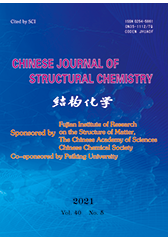Computational Insights into the Excited State Intramolecular Proton Transfer Reactions in Ortho-hydroxylated Oxazolines
LIU Gai-Mei, MA Wei-Jia, WANG Yan*, YANG Yan and SONG Xin-Jian
Chin. J. Struct. Chem. 2021, 40, 540-548 DOI: 10.14102/j.cnki.0254-5861.2011-2990
May 15, 2021
xcited-state intramolecular proton transfer, electron donating group, ortho-hydroxylated oxazolines, potential energy curves
ABSTRACT
Excited-state
intramolecular proton transfer (ESIPT) reactions of three ortho-hydroxylated oxazolines, 2-(4,4-dimethyl-4,5-dihydro-oxazol-2-yl)-phenol (DDOP),
4-(4,4-dimethyl-4,5-dihydro-oxazol- 2-yl)-[1,1΄-biphenyl]-3-ol (DDOP-C6H5)
and 4-(4,4-dimethyl-4,5-dihydrooxazol-2-yl)-3-hydroxy-benzonitrile (DDOP-CN), have
been systematically explored by density functional theory (DFT) and
time-dependent density functional theory (TDDFT) methods. Two stable
configurations (enol and keto forms) are found in the ground states (S0) for all the compounds while
the enol form only exists in the first excited states (S1) for the compound modified with electron donating
group (-C6H5). In addition, the calculated absorption and
emission spectra of the compounds are in good agreements with the experiments. Infrared
vibrational spectra at the hydrogen bond groups demonstrate that the
intramolecular hydrogen bond O(1)−H(2)···N(3) in DDOP-C6H5 is strengthened in the S1 states, while the frontier
molecular orbitals further reveal that the ESIPT reactions are more likely to
occur in the S1 states for
all the compounds. Besides, the proton transfer potential energy curves show
that the enol forms can barely convert into keto forms in the S0 states because of the high
energy barriers. Meanwhile, intramolecular proton transfer of all the compounds
could occur in S1 states.
The ESIPT reactions of the ortho-hydroxylated
oxazolines are barrierless processes for unsubstituted DDOP and electron withdrawing
substituted DDOP-CN, while the electron donating substituted
DDOP-C6H5 has a
small barrier, so the electron donating is unfavorable to the ESIPT reactions
of ortho-hydroxylated oxazolines.








